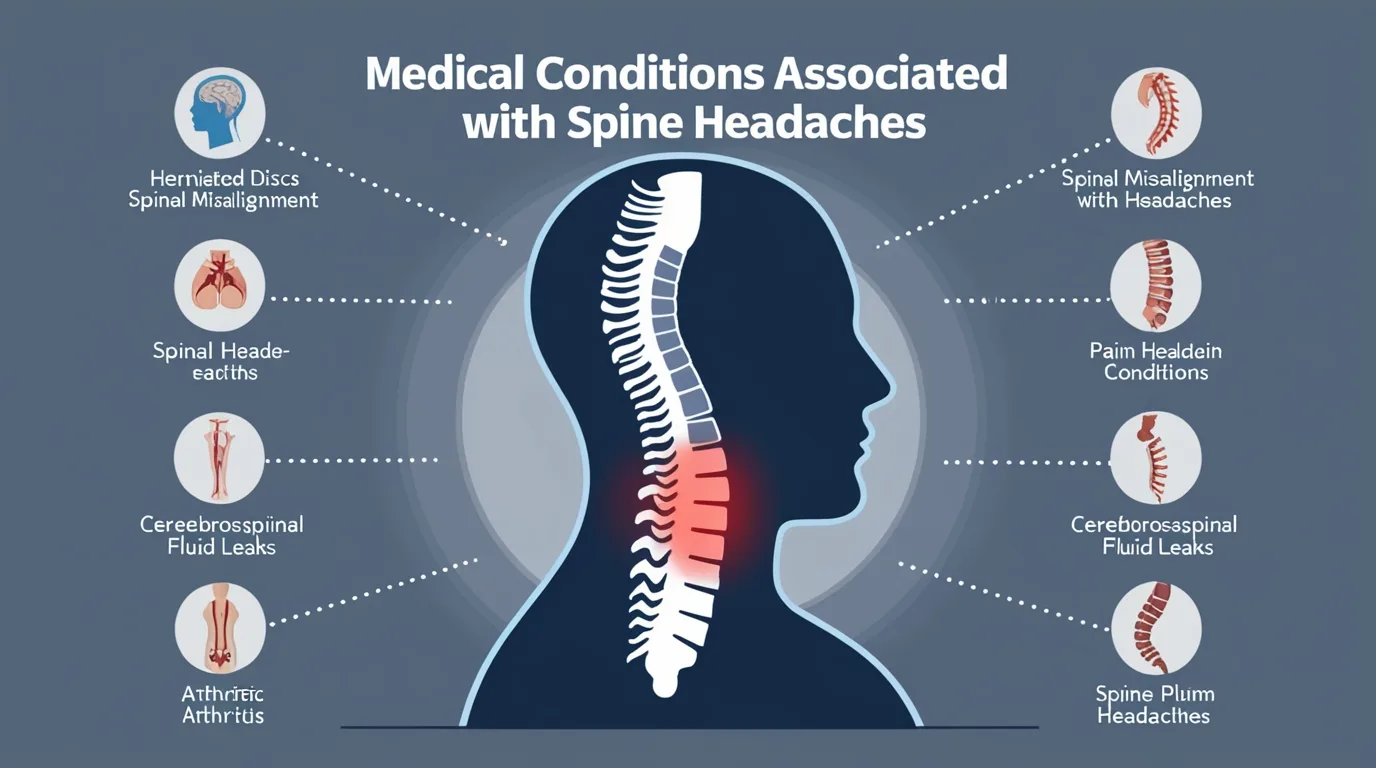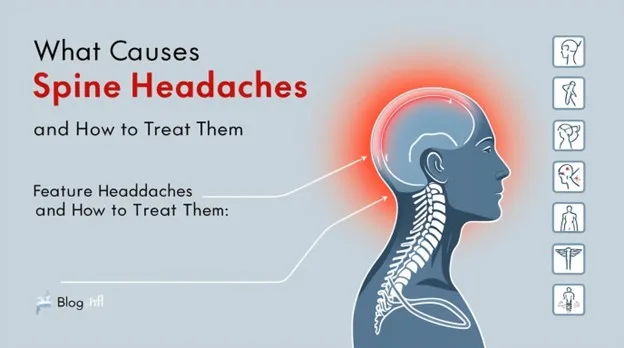Understanding Spine Headaches
Introduction to Spine Headaches
Definition and characteristics
Spine headaches, also known as cervicogenic headaches are the type of pain that originates in the neck and radiates to the head. These headaches are often described as a dull, aching pain that starts at the base of the skull and moves upward. Unlike other types of headaches, spine headaches are directly related to issues in the cervical spine.
Prevalence and demographics
Spine headaches affect a significant portion of the population, with studies suggesting that up to 4% of people experience them. They’re more common in adults, particularly those between the ages of 30 and 50. Women are slightly more likely to suffer from spine headaches than men.
Differentiating Spine Headaches from Other Types
It’s crucial to distinguish spine headaches from other types of headaches, such as migraines or tension headaches. Spine headaches typically worsen with neck movement and are often accompanied by neck stiffness or reduced range of motion. Unlike migraines, they rarely cause nausea or sensitivity to light and sound.
Anatomy of the Spine and Its Relation to Headaches
Structure of the cervical spine
The cervical spine consists of seven vertebrae, labeled C1 to C7. These vertebrae are separated by intervertebral discs and connected by various ligaments and muscles. Understanding this structure is key to grasping how spine issues can lead to headaches.
Nerves and blood vessels in the neck region
The neck region is home to numerous nerves and blood vessels that play a role in head and neck function. The occipital nerves, which run from the top of the spinal cord to the scalp, are particularly important in the context of spine headaches.
Connection Between Spine and Head
The close relationship between the spine and the head means that problems in the neck can easily translate to head pain. This connection is why addressing spine issues is often crucial in treating these headaches effectively.
Common Causes of Spine Headache
Poor posture and ergonomics
Many of us spend hours hunched over desks or looking down at our phones. This poor posture puts strain on the neck muscles and can lead to spine headaches. I’ve personally experienced this after long work sessions at my computer.
Muscle tension and strain
Stress, anxiety, and physical exertion can cause muscle tension in the neck and shoulders. This tension can compress nerves and blood vessels, triggering headaches.
Spinal misalignment and subluxations
When the vertebrae in your neck are out of alignment, it can irritate nerves and cause pain that radiates to your head. This misalignment can be caused by injury, repetitive motions, or even sleeping in an awkward position.
Medical Conditions Associated with Spine Headaches

Cervical spondylosis
This age-related wear and tear of the cervical spine can lead to chronic neck pain and headaches. It’s a common condition in older adults and can significantly impact their quality of life.
Herniated discs
When the soft inner portion of a spinal disc pushes through the tougher outer ring, it can put pressure on nearby nerves, causing pain that radiates to the head.
Spinal Stenosis
This narrowing of the spinal canal can compress nerves in the neck, leading to pain, numbness, and headaches. It’s often a result of aging but can also be caused by injuries or other conditions.
Diagnosis of Spine Headache
Physical examination and medical history
A healthcare provider will typically start by asking about your symptoms and medical history. They’ll perform a physical exam, checking your neck’s range of motion and looking for areas of tenderness.
Imaging tests (X-rays, MRI, CT scans)
These tests can provide detailed images of your spine, helping to identify any structural issues that might be causing your headaches. I remember feeling anxious before my first MRI, but the process was much easier than I expected.
Diagnostic nerve blocks
In some cases, a doctor may inject a local anesthetic near certain nerves to see if it relieves your headache. This can help pinpoint the exact source of the pain.
Conservative Treatment Options
Physical therapy and exercises
A physical therapist can teach you exercises to strengthen neck muscles and improve posture. These exercises have been a game-changer for many people I know who suffer from spine headaches.
Chiropractic care and spinal manipulation
Chiropractors use hands-on spinal manipulation to improve alignment and relieve pain. While some people swear by this treatment, it’s important to consult with your doctor first to ensure it’s safe for you.
Massage therapy and soft tissue techniques
Massage can help relax tense muscles in the neck and shoulders, potentially reducing the frequency and intensity of spine headaches. I’ve found regular massages to be incredibly helpful in managing my own neck tension.
Medication and Pain Management
Over-the-counter pain relievers
Nonsteroidal anti-inflammatory drugs (NSAIDs) like ibuprofen can help reduce pain and inflammation. However, it’s important not to rely on these medications long-term without addressing the underlying cause.
Prescription medications
In some cases, doctors may prescribe muscle relaxants or other medications to help manage spine headaches. Always follow your doctor’s instructions when taking prescription drugs.
Nerve blocks and injections
For severe or persistent cases, a doctor might recommend nerve blocks or corticosteroid injections to provide longer-lasting pain relief.
Lifestyle Changes and Prevention
Improving posture and ergonomics
Simple changes like adjusting your computer screen height or using a supportive pillow can make a big difference. I’ve found that setting reminders to check my posture throughout the day has been helpful.
Stress management techniques
Stress can exacerbate spine headaches, so finding effective ways to manage stress is crucial. This might include meditation, deep breathing exercises, or regular exercise.
Regular exercise and stretching routines
Incorporating neck and shoulder stretches into your daily routine can help prevent muscle tension and reduce the likelihood of spine headaches. Swimming and yoga have been particularly beneficial for me.
Alternative and Complementary Therapies
Acupuncture
This traditional Chinese medicine technique involves inserting thin needles into specific points on the body. Some people find it effective for managing spine headaches, though scientific evidence is mixed.
Yoga and mindfulness practices
Gentle yoga can help improve posture and reduce stress, potentially lessening the frequency of spine headaches. Mindfulness practices can also help you become more aware of the tension in your body.
Herbal supplements and natural remedies
Some people find relief with herbal remedies like feverfew or butterbur. However, it’s important to consult with a healthcare provider before trying any new supplements, as they can interact with medications. DESMODIUM is also a natural remedy that is available on eHomeo Store, and you can use it.
When to Seek Professional Help
Red flags and warning signs
If you experience sudden, severe headaches, headaches accompanied by fever, or vision changes, or if your headaches are getting progressively worse, seek medical attention immediately.
Choosing the right healthcare provider
Finding a healthcare provider who specializes in headaches and spine issues can make a big difference in your treatment. Don’t hesitate to seek a second opinion if you’re not satisfied with your current care.
Importance of early intervention
The sooner you address spine headaches, the better your chances of finding effective relief. Don’t ignore persistent neck pain or headaches – seek help early.
Summary
Spine headaches can be debilitating, but with proper diagnosis and treatment, most people can find relief. By understanding the causes, exploring various treatment options, and making lifestyle changes, you can take control of your spine headaches and improve your quality of life.
Frequently Asked Questions (FAQs):
Can spine headaches be cured permanently?
While there’s no guaranteed permanent cure, many people find long-term relief through a combination of treatments and lifestyle changes.
How long does it take to recover from spine headaches?
Recovery time varies depending on the cause and chosen treatments. Some people find relief quickly, while others may need several weeks or months of consistent treatment.
Are spine headaches related to migraines?
While they’re different conditions, some people may experience both spine headaches and migraines. It’s important to get an accurate diagnosis to ensure proper treatment.
Can children experience spine headaches?
While less common, children can experience spine headaches. If your child complains of persistent neck pain and headaches, consult a pediatrician.
What is the best sleeping position for spine headache sufferers?
Sleeping on your back with a supportive pillow that maintains the natural curve of your neck is often recommended. However, the best position can vary from person to person.

